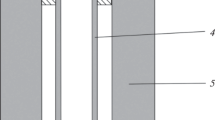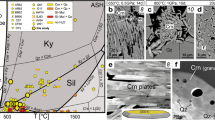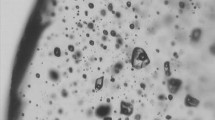Abstract—
The kinetics of reactions between minerals and water vapor or two water phases simultaneously (liquid + vapor) is still understood inadequately poorly, and the absence of these data disable realistic and comprehensive quantitative description of the evolution of hydrothermal system after its fluid heterogenizes. To bridge this gap, we have conducted quenching experiments with quartz crystals and water at 300°C and Psat = 86 bar. In addition to usually applied analytical techniques (ICP-AES, SEM, XRD, and optical microscopy), we used 3d scanning of the crystals, measured their surface areas, and plotted the changes in the crystal sizes because of dissolution and deposition reactions. In the experimental runs with the crystal occurring in the vapor phase, the first ever data were acquired on the rate constant of quartz dissolution for saturated water vapor (Psat = 86 bar) at 300°C (2.7 nmol m–2 s–1). The constant turned out to be 630 times lower than that for pure water. Calculations indicate that equilibrium between quartz and water and vapor is established during comparable time spans, but quartz recrystallization in vapor due to the temperature gradient proceeds two orders of magnitude more slowly than in water. In the runs with the crystal occurring in both water and vapor, not only the stable quartz dissolved, but also metastable cristobalite-tridymite opal was formed. The opal was deposited on the autoclave walls and even on the quartz itself above the water surface, and the silica concentration in the water remained remarkably lower that the quartz solubility. The rate of opal formation (10–7.5 mol m–2 s–1) was 3.5 orders of magnitude higher than the quartz recrystallization rate (which is the only process possible in this system according to the traditional geochemical approach). This disagreement is explained within the framework of the distillation hypothesis, which is based on the preferential evaporation of the thin (<100 nm) solution layer at the meniscus edge. The system is found out to be able to evolve according to two scenarios, which result in the scattered and compact opal deposition because of the different ratios of the ascent velocity of the solution film and the evaporation rate. This phenomenon may explain the asymmetry of naturally occurring crystallization cavities, whose lower parts dissolved, and minerals were deposited in the upper parts.






Similar content being viewed by others
REFERENCES
A. W. Adamson and A. P. Gast, Physical Chemistry of Surfaces, 6th ed. (John Wiley & Sons, New York, 1997).
V. A. Alekseyev, “Nanoparticles and nanofluids in water–rock interactions,” Geochem. Int. 57 (4), 357–368 (2019).
V. A. Alekseyev and L. S. Medvedeva, “Silica distribution in the system quartz–water–vapor depending on the temperature gradient,” Geochem. Int. 56 (2), 136–147 (2018).
V. A. Alexeyev, L. S. Medvedeva, and N. P. Starshinova, “Paradoxical transformation of the equilibrium quartz–water system into an unequilibrated one,” Geochem. Int. 51 (5), 382–404 (2013).
V. A. Alekseyev, L. S. Medvedeva, V. N. Balashov, A. A. Burmistrov, and I. N. Gromyak, “Experimental study of unequilibrated silica transfer from liquid water to the vapor phase,” Geochem. Int. 56 (7), 617–627 (2018).
V. Alekseyev, V. Balashov, L. Medvedeva, and A. Opolchentsev, “Spontaneous distillation of silica-bearing solution in closed system with rough walls,” E3S Web of Conferences 98, 04001 (2019).
A. M. Askhabov, Crystal Genesis and Evolution of the “Crystal–Medium” System (Nauka, St. Petersburg, 1993) [in Russian].
P. Bettermann and F. Liebau, “The transformation of amorphous silica to crystalline silica under hydrothermal conditions,” Contrib. Mineral. Petrol. 53, 25–36 (1975).
J. Bico, U. Thiele, and D. Quéré, “Wetting of textured surfaces,” Colloids and Surfaces A 206, 41–46 (2002).
C. Buffone and K. Sefiane, “Investigation of thermocapillary convective patterns and their role in the enhancement of evaporation from pores,” Int. J. Multiphase Flow 30 (9), 1071–1091 (2004a).
C. Buffone and K. Sefiane, “IR measurements of interfacial temperature during phase change in a confined environment,” Experim. Therm. Fluid Sci. 29 (1), 65–74 (2004b).
C. Buffone, K. Sefiane, and J. R. E. Christy, “Experimental investigation of the hydrodynamics and stability of an evaporating wetting film placed in a temperature gradient,” Applied Therm. Engineering 24 (8–9), 1157–1170 (2004).
J. D. Dana, E. S. Dana, and C. Frondel, System of Mineralogy. Volume 3. Silica Minerals (Wiley, New York. 1962).
P. M. Dove, “Kinetic and thermodynamic controls on silica reactivity in weathering environments,” Rev. Mineral. 31, 235–290 (1995).
S. R. Friedman, M. Khalil, and P. Taborek, “Wetting transition in water,” Phys. Rev. Lett. 111, (22), 226101 (2013).
J.-M. Gautier, E. H. Oelkers, and J. Schott, “Are quartz dissolution rates proportional to B.E.T. surface areas?,” Geochim. Cosmochim. Acta 65 (7), 1059–1070 (2001).
H. Graetsch, H. Gies, and I. Topalović, “NMR, XRD and IR study on microcrystalline opals,” Phys. Chem. Minerals 21, 166–175 (1994).
T. Hofmann, M. Tasinkevych, A. Checco, E. Dobisz, S. Dietrich, and B. M. Ocko, “Wetting of nanopatterned grooved surfaces,” Phys. Rev. Lett. 104 (10), 106102 (2010).
M. Hosaka and S. Taki, “Hydrothermal growth of quartz crystals at low fillings in NaCl and KCl solutions,” J. Cryst. Growth 78, 413–417 (1986).
C. M. Isaacs, “Influence of rock composition on kinetics of silica phase changes in the Monterey Formation, Santa Barbara area, California,” Geology 10, 304–308 (1982).
P. B. Kowalczuk, C. Akkaya, M. Ergun, M. J. Janicki, O. Sanbaz, and J. Drzymala, “Water contact angle on corresponding surfaces of freshly fractured fluorite, calcite and mica,” Physicochem. Probl. Miner. Process. 53 (1), 192–201 (2017).
R. Lefebvre, D. Hockley, J. Smolensky, and P. Gélinas, “Multiphase transfer processes in waste rock piles producing acid mine drainage: 1. Conceptual model and system characterization,” J. Contam. Hydrol. 52 (3–4), 137–164 (2001).
Yu. M. Lukashov, V. F. Fursenko, and A. S. Popov, “Method of experimental study of silica acid distribution between boiling water and equilibrium vapor in a wide range of pressure and concentrations, Questions of Warming and Ventilation, ed. by E. A. Shtokman (Min. Vyssh. Sred. Spets. Obrazov. RSFSR, Rostov on Don, 1971), pp. 113–123 [in Russian].
B. Y. Lynne, K. A. Campbell, J. N. Moore, and P. R. L. Browne, “Diagenesis of 1900-year-old siliceous sinter (opal-A to quartz) at Opal Mound, Roosevelt Hot Springs, Utah, U.S.A,” Sediment. Geol. 179, 249–278 (2005).
A. Mazurek, S. J. Pogorzelski, and K. Boniewicz–Szmyt, “Adsorption of natural surfactants present in sea waters at surfaces of minerals: Contact angle measurements,” Oceanologia 51 (3), 377–403 (2009).
A. Okamoto, H. Saishu, N. Hirano, and N. Tsuchiya, “Mineralogical and textural variation of silica minerals in hydrothermal flow-through experiments: implications for quartz vein formation,” Geochim. Cosmochim. Acta 74 (13), 3692–3706 (2010).
J. L. Plawsky, M. Ojha, A. Chatterjee, and P. C. Wayner, Jr., “Review of the effects of surface topography, surface chemistry, and fluid physics on evaporation at the contact line,” Chem. Engin. Commun. 196, 658–696 (2008).
A. V. Plyasunov, “Thermodynamics of Si(OH)4 in the vapor phase of water: Henry’s and vapor–liquid distribution constants, fugacity and cross virial coefficients,” Geochim. Cosmochim. Acta 77, 215–231 (2012).
J. D. Rimstidt and H. L. Barnes, “The kinetics of silica–water reactions,” Geochim. Cosmochim. Acta 44 (11), 1683–1699 (1980).
K. Sefiane and C. A. Ward, “Recent advances on thermocapillary flows and interfacial conditions during the evaporation of liquids,” Adv. Colloid Interface Sci. 134–135, 201–223(2007).
A. L. Senkayi, J. B. Dixon, L. R. Hossner, B. P. K. Yerima, and L. P. Wilding, “Replacement of quartz by opaline silica during weathering of petrified wood,” Clays Clay Miner. 33 (6), 525–531 (1985).
J. W. Tester, W. G. Worley, B. A. Robinson, et al., “Correlating quartz dissolution kinetics in pure water from 25 to 625°C,” Geochim. Cosmochim. Acta 58 (11), 2407–2420 (1994).
W. J. P. Van Enckevort and J. H. Los, “On the creeping of saturated salt solutions,” Cryst. Growth Des. 13 (5), 1838–1848 (2013).
M. P. Verma, “Chemical thermodynamics of silica: a critique on its geothermometer,” Geothermics 29, 323–346 (2000).
L. A. Williams and D. A. Crerar, “Silica diagenesis, II. General mechanisms,” J. Sediment. Petrol. 55 (3), 312–321 (1985).
ACKNOWLEDGMENTS
The authors thank N.N. Akinfiev and V.S. Balitskii for valuable comments, which helped us to improve the manuscript.
Author information
Authors and Affiliations
Corresponding author
Additional information
Translated by E. Kurdyukov
Rights and permissions
About this article
Cite this article
Alekseyev, V.A., Burmistrov, A.A. & Gromiak, I.N. Quartz Transformation into Opal at the Water–Vapor Interface. Geochem. Int. 59, 377–387 (2021). https://doi.org/10.1134/S0016702921040029
Received:
Revised:
Accepted:
Published:
Issue Date:
DOI: https://doi.org/10.1134/S0016702921040029




